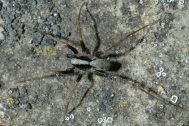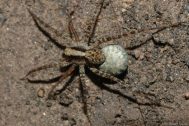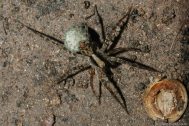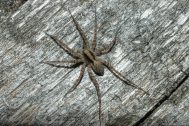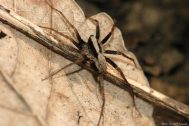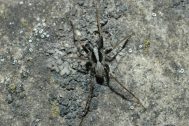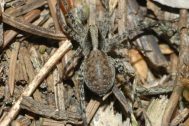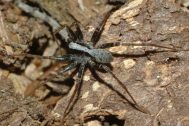| Records by time | |||||
|---|---|---|---|---|---|
| Lycosidae | 0-1900 | 1901-1950 | 1951-2000 | 2001+ | ∑ |
| Pardosa lugubris (Walckenaer, 1802) Not endangered | 3× | 1659× | 679× | 2341× | |
Pardosa lugubris (Walckenaer, 1802)
| Czech name | slíďák hajní |
|---|---|
| Threat level | Not endangered |
| Records | 2341 nálezů, 342 kvadrátů |
| First record |
1866, E. Bárta, Bárta 1869 |
| Last record | 2024 , Ondřej Machač |
| Distribution area | Palaearctic - Transp. |
| Phytogeographic area |
|
| Původnost stanovišť |
|
| Humidity |
|
| Stratum |
|
| Osvětlení stanovišť |
|
| Hojnost výskytu |
|
| Altitude | 150-1350 |
Bibliography
Contact exposure to neonicotinoid insecticides temporarily suppresses the locomotor activity of Pardosa lugubris agrobiont wolf spiders.
Exposure to numerous chemicals disrupts the spiders’ locomotion. Spiders, particularly epigeic spiders, are dependent on their locomotory activities to search for prey, hide from their enemies, and perform sexual reproduction and subsequent parental care. Among the best-known compounds that inhibit the locomotion of arthropods are neonicotinoids. Despite spiders are less affected by the neonicotinoids than insects due to the sequence differences in their acetylcholine receptors, they are not resistant to these compounds. We hypothesized that acute exposure to a broad spectrum of neonicotinoids suppresses the traveled distance, mean velocity, and maximum velocity in epigeic spiders. As a model species, we used adults of Pardosa lugubris. We tested commercial formulations of thiamethoxam, acetamiprid, and thiacloprid. We tested each of the neonicotinoids in the maximum and minimum concentrations recommended for foliar applications. We applied them under controlled conditions dorsally by spraying them directly on the spiders or exposing the spiders to the tarsal contact with neonicotinoid residues. Control groups consisted of 31 individuals; treated groups consisted of 10–21 individuals. We found that a broad spectrum of neonicotinoids temporarily suppresses the traveled distance in epigeic spiders. At 1 h after application, all the three tested neonicotinoid insecticides induced declines in the traveled distance, but this effect mostly disappeared when tested at 24 h after the application. The decrease in the traveled distance was associated with substantial temporary decreases in the mean and maximum velocities. Despite differences among modalities, all three insecticides caused multiple adverse effects on the locomotory parameters in any tested concentrations. It remains to test what would be the lowest safe concentration for the chronic exposure to neonicotinoids in epigeic spiders.
Subletální efekty insekticidů neonikotinoidů na migrační potenciál pavouků
Důvodem používání pesticidů je hubení organismů způsobujících škody (tzv. škůdci) na různých plodinách a díky tomu zabránit případným ztrátám na úrodě. Jejich nežádoucím účinkem je negativní dopad na necílové organismy.
Předložená diplomová práce je zaměřena na vliv neonikotinoidů na bezobratlé živočichy, a to konkrétně na pavouky. Jejím hlavním cílem bylo zdokumentovat jejich vliv na behaviorální parametry ovlivňující migrační schopnosti, jako jsou lokomoce a tendence k šíření pomocí větru (tzv. ballooning). Práce porovnává vliv neonikotinoidů na modelové druhy, Pardosa lugubris (Walckenaer, 1802) a Phylloneta impressa (L. Koch, 1881) s různým způsobem lovu kořisti a srovnává u nich vliv na adultní a nymfální stádia. V laboratorních podmínkách byly na pavouky aplikovány pesticidy Actara ® 25 WG, Biscaya ® 240 OD, Confidor ® 200 OD a Mospilan ® 20 SP a byl testován jejich účinek při rozdílných koncentracích a různých způsobech aplikace.
Největší dopad na pavouky měl přípravek Confidor. Měl jednoznačně nejvýraznější negativní vliv na mobilitu a tendenci k šíření pomocí větru pavouků. Letální účinky způsobily neonikotinoidy u nymfálních jedinců Pardosa lugubris, a to zejména přípravek Confidor (u tarzální aplikace dokonce i 100% úmrtnost). Během pokusu studujícím vliv na lokomoci u adultních jedinců Pardosa lugubris bylo zjištěno, že došlo po 24 hodinách k výraznému odeznění paralýzy způsobené neonikotinoidy.
Epigeic spiders from oak-hornbeam woodland in the Děvín National Nature Reserve (Czech Republic).
Data on the spider fauna from the forest ecosystems of the Děvín National Nature Reserve (South Moravia, Czech Republic) are presented. The research was carried out on 15 randomly chosen research plots in oak-hornbeam forest stands within different management regimes. Spider sampling was done by pitfall trapping from May to October 2016. Overall, 3683 adult spiders belonging to 22 families, 70 genera and 116 species were collected. The families Linyphiidae, Lycosidae, Gnaphosidae and Thomisidae exhibited high species richness. The most abundant species were Pardosa lugubris (Walckenaer, 1802) and Trochosa terricola Thorell, 1856. Faunistically remarkable species were Atypus piceus (Sulzer, 1776), Drassyllus villicus (Thorell, 1875), Gnaphosa montana (L. Koch, 1866), Panamomops affinis Miller & Kratochvíl, 1939 and Walckenaeria monoceros (Wider, 1834). The record of Gnaphosa montana is one of the first accounts of this psychrophilic spider from European lowlands. Of the identified species, 23 are listed in the Red List of Threatened Species in the Czech Republic (EN – 1 species, VU – 12 species, LC – 10 species).Synergistic effects of glyphosate formulation herbicide and tank-mixing adjuvants on Pardosa spiders.
Glyphosate-based herbicides are the world’s most consumed agrochemicals, and they are commonly used in various agroecosystems, including forests, as well as in urban zones and gardens. These herbicides are sold as formulations containing adjuvants. Other tank-mixing adjuvants (most often surfactants) are commonly added to these formulations prior to application. According to the manufacturers of agrochemicals, such tank mixes (as these are known in agronomic and horticultural practice) have modified properties and perform better than do the herbicides as used alone. The effects of these tank mixes on the environment and on beneficial arthropods are almost unknown. Therefore, we studied whether a herbicide formulation mixed with adjuvant has modified effects on one of the most common genera of ground-dwelling wolf spiders vis- a-vis the herbicide formulation and adjuvants themselves. Specifically, we studied the synergistic effect in the laboratory on the predatory activity (represented by the number of killed flies) of wolf spiders in the genus Pardosa after direct treatment using the glyphosate-based herbicide formulation Roundup klasik Pro ® , Roundup klasik Pro ® in a mixture with the surfactant Wetcit ® , Roundup klasik Pro ® in a mixture with the surfactant Agrovital ® , and the surfactants alone. We found that pure surfactants as well as herbicide-and-surfactants tank mixes significantly decrease the predatory activity of Pardosa spiders in the short term even as Roundup klasik Pro ® did not itself have any such effect. Our results support the hypothesis that plant protection tank mixes may have modified effect on beneficial arthropods as compared to herbicide formulations alone. Therefore, testing of pesticide tank mixes is highly important, because it is these tank mixes that are actually applied to the environment.Epigeic Spiders from Lowland Oak Woodlands in the South Moravia Region (Czech Republic).
This paper presents spider faunistics from abandoned coppice oak forest stands located along the South Moravia region. Spiders were collected from May to July 2012 by pitfall trapping at eight different localities. We collected 1945 adult spiders representing 20 families, 53 genera, and 90 species. More than one-third of all the species are known to be xerothermophilous with ecological restrictions to open and partly shaded habitats such as forest-steppe and sparse forests which belong to endangered habitats along central Europe. The most abundant species were Pardosa alacris, Pardosa lugubris and Arctosa lutetiana from the family Lycosidae. In the surveyed area, 24 species were found listed in the Red List of Threatened Species in the Czech Republic (CR – 1 species, EN – 2 species, VU – 15 species, LC – 6 species). In general, we discovered a substantially diversified spider community with a large presence of rare and endangered species characteristic for open and xeric habitats.
Gallery
Statistics
By month
By altitude
By collecting method (2340 used records)
| Pardosa lugubris (Walckenaer, 1802) ES | Males | Females | Juveniles | Records |
|---|---|---|---|---|
| Prosev | 32 | 46 | 2 | 31 |
| Individuální sběr | 307 | 342 | 17 | 245 |
| Zemní past | 8712 | 3862 | 1035 | 1572 |
| Neurčeno | 643 | 675 | 3 | 399 |
| Žlutá miska | 4 | 13 | 0 | 9 |
| Smyk | 53 | 76 | 0 | 45 |
| Sklepávání | 206 | 114 | 1 | 22 |
| Eklektor | 16 | 2 | 33 | 17 |
| Males | Females | Juveniles | Records |
By biotope (2341 used records)
| Pardosa lugubris (Walckenaer, 1802) ES | Males | Females | Juveniles | Records |
|---|---|---|---|---|
| Výsadby listnáčů | 283 | 323 | 0 | 14 |
| Skalní stepi na jiných horninách | 1 | 0 | 0 | 1 |
| Suché doubravy | 562 | 190 | 23 | 80 |
| Suché louky | 16 | 29 | 1 | 17 |
| Kamenolomy | 193 | 51 | 3 | 34 |
| Lesy | 6 | 14 | 0 | 55 |
| Paseky | 423 | 185 | 1 | 85 |
| Louky | 3 | 8 | 0 | 30 |
| Dubohabřiny | 79 | 98 | 3 | 17 |
| Suťové a roklinové lesy | 35 | 3 | 0 | 14 |
| Lužní lesy nížin | 875 | 271 | 38 | 62 |
| Mokřady | 33 | 0 | 0 | 18 |
| Neurčeno | 1801 | 1712 | 700 | 813 |
| Kosodřevina | 0 | 0 | 0 | 1 |
| Louky | 86 | 23 | 0 | 17 |
| Horské smrčiny | 20 | 9 | 2 | 15 |
| Mezofilní louky | 36 | 26 | 0 | 17 |
| Mokré louky | 375 | 44 | 0 | 31 |
| Bučiny nižších poloh | 195 | 52 | 2 | 50 |
| Rašeliniště | 119 | 55 | 0 | 48 |
| Zahradnicky utvářené zahrady a parky | 30 | 5 | 0 | 3 |
| Reliktní bory na skalách | 39 | 13 | 3 | 19 |
| Podmáčené smrčiny | 11 | 5 | 0 | 4 |
| Horské bučiny | 51 | 22 | 11 | 24 |
| Těžebny písku a jiných nezpevněných hornin | 28 | 66 | 0 | 15 |
| Lesy | 1536 | 437 | 90 | 190 |
| Výsadby jehličnanů | 815 | 404 | 179 | 139 |
| Vrbové křoviny - vlhké (vrbové) křoviny | 0 | 3 | 0 | 3 |
| Suché lesní lemy | 0 | 2 | 0 | 2 |
| Vřesoviště nižších poloh | 9 | 6 | 0 | 3 |
| Lesní okraje | 471 | 244 | 16 | 75 |
| Xerotermní travinobylinná společenstva | 46 | 68 | 0 | 36 |
| Ruderály | 175 | 47 | 0 | 14 |
| Suché křoviny | 66 | 24 | 0 | 18 |
| Travnaté stepi | 1 | 0 | 0 | 1 |
| Jasanoolšové lemy vodotečí | 27 | 8 | 0 | 1 |
| Vlhké doubravy | 0 | 1 | 0 | 1 |
| Ovocné sady s luční vegetací | 193 | 43 | 0 | 31 |
| Ostřicové porosty stojatých vod | 3 | 1 | 0 | 3 |
| Mokřadní olšiny | 350 | 43 | 1 | 33 |
| Okraje silnic | 78 | 48 | 0 | 10 |
| Skalní stepi na vápenci | 37 | 20 | 0 | 8 |
| Rašelinné bory | 107 | 39 | 5 | 36 |
| Luční ostřicové mokřady | 2 | 3 | 0 | 4 |
| Pastviny | 4 | 1 | 0 | 4 |
| Břehy tekoucích vod | 15 | 13 | 0 | 19 |
| Ovocné sady a vinohrady | 2 | 0 | 0 | 2 |
| Močály | 13 | 10 | 0 | 14 |
| Lesostepní doubravy | 46 | 156 | 11 | 26 |
| Kamenité suti nižších poloh | 15 | 25 | 0 | 21 |
| Písčiny | 5 | 26 | 0 | 8 |
| Vlhké lesní lemy | 29 | 2 | 0 | 3 |
| Bylinné porosty břehů | 2 | 8 | 0 | 6 |
| Těžební jámy | 0 | 2 | 0 | 1 |
| Úhory | 4 | 3 | 0 | 4 |
| Štěrkové břehy řek | 0 | 1 | 0 | 2 |
| Haldy a výsypky | 4 | 1 | 0 | 11 |
| Přirozené lesy | 14 | 11 | 0 | 11 |
| Stinné skály nižších poloh | 264 | 87 | 0 | 32 |
| Louky a pastviny | 1 | 2 | 0 | 3 |
| Porosty borůvek | 119 | 62 | 0 | 22 |
| Lesy vyšších poloh a strmých svahů | 5 | 2 | 1 | 8 |
| Rákosiny a orobincové porosty stojatých vod | 14 | 11 | 0 | 10 |
| Lesní cesta | 10 | 10 | 0 | 7 |
| Bahnité břehy | 4 | 0 | 0 | 1 |
| Slaniska | 2 | 3 | 0 | 2 |
| Stojaté a pomalu tekoucí vody | 59 | 31 | 0 | 3 |
| Acidofilní bory | 65 | 12 | 0 | 16 |
| Ostatní pole | 5 | 0 | 0 | 5 |
| Písčité břehy | 11 | 2 | 0 | 4 |
| Polní biotopy | 44 | 4 | 0 | 2 |
| Horská vřesoviště | 1 | 3 | 0 | 1 |
| Skalní a suťové biotopy | 0 | 0 | 1 | 1 |
| Males | Females | Juveniles | Records |





